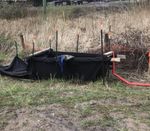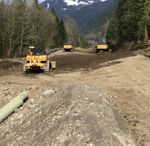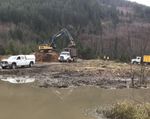INDIGENOUS MONITOR OVERVIEW REPORT - Trans Mountain
←
→
Page content transcription
If your browser does not render page correctly, please read the page content below
INDIGENOUS MONITOR
OVERVIEW REPORT
Month: April2021 Indigenous Monitor days on-site: 26
Project Region: Coquihalla Hope Kilometre Posts (KPs) monitored:
Spread 5B KP 1020–1075
Indigenous Monitors on the Trans Mountain Expansion Project – Overview
The Trans Mountain Expansion Project (the Project) has retained Indigenous Monitors as
integrated members of its construction Environmental Inspection team. Indigenous Monitors
work with Environmental Inspectors to monitor compliance with mitigation measures to
minimize impacts to traditional resource use and cultural/heritage sites during construction.
Indigenous Monitors have a strategic role in providing traditional knowledge directly and
pragmatically to construction oversight practices and bring an Indigenous lens to daily
environmental inspection activities.
This Overview Report provides highlights of the Indigenous Monitors’ day-to-day work and key
mitigation measures observed by the Monitors related to Project construction in the Coquihalla
Hope Region. The purpose of this report is to provide an update on Indigenous Monitor activity
to Indigenous groups.
During this reporting period, key activities in the Coquihalla Hope Region involving Indigenous
Monitors took place from KP 1020 to 1075 in Spread 5B and included monitoring log hauling,
de-watering management, topsoil stripping and grading, and culturally modified tree
assessments. The Project Construction Progress Report (Condition 106) for April 2021, which
reports environmental events and deficiencies in Tables 4 and 5 respectively, is found here.
For more information: email info@transmountain.com or call 1.866.514.6700.
Trans Mountain COVID-19 – Our Response
Trans Mountain is actively monitoring the COVID-19 situation with the help of federal, provincial
and local agencies. Trans Mountain’s top priority remains the health and safety of its workforce,
their families and our communities. Trans Mountain and its construction contractors are
working diligently together to adhere to all advice and direction from government and health
officials, while ensuring the safe uninterrupted operation of the Trans Mountain Pipeline and the
continued, safe construction of the Expansion Project. Measures being undertaken at
construction sites include: temperature screening; following physical distancing guidelines,
staggering work shifts and breaks; eliminating or minimizing in-person meetings; enhancing
cleaning and sanitizing; and ensuring workers’ orientation includes COVID 19 expectations,
awareness and prevention.
For more information: transmountain.com/covid19
Indigenous Monitor Overview Report Page 1
Coquihalla Hope Region – April 2021Topsoil Stripping and Grading
At KP 1073, topsoil stripping and grading activities
are taking place. When removing topsoil, there are
several required mitigations including the
inspection of topsoil pile(s) to ensure they are
within the survey limits of the right-of-way and no
soil has gone outside these limits. Appropriate
construction equipment must also be used during
topsoil stripping when frozen ground conditions are
encountered.
The Indigenous Monitors have been involved in
monitoring and inspecting such topsoil stripping
mitigations. They also inspect the cleared area to
investigate any potential chance finds that could be
Grading activities near KP 1073.
unearthed. No issues or chance finds were
identified.
Log Hauling
Log hauling and chip hauling activities were
observed near Karen Creek. Trans Mountain has a
Timber Salvage Plan outlining practices around
management and handling of trees cleared along
the Project right-of-way. Trans Mountain is working
with Indigenous communities that have identified
timber salvage interests.
The Indigenous Monitors conduct inspections
to confirm the haul trucks are washed
thoroughly before entering the site. This
reduces the risk for introducing and spreading
noxious weeds and soil pathogens.
Indigenous Monitors worked with the loader on-site
to monitor log integrity. This prevents
waste of merchantable timber.
In warm weather conditions, topsoil tracking
is a high priority. Rutting, admixing and
compaction are closely monitored while the
haul trucks are on-site. No concerns were identified
during the inspection. Chip hauling for future reclamation activities near
KP 1020.
Indigenous Monitor Overview Report Page 2
Coquihalla Hope Region – April 2021De-watering Management
Near KP 1074, during construction activity,
water that accumulates within the Project area
from precipitation or groundwater seepage is
visually assessed prior to being pumped to
areas approved by the Trans Mountain
Environmental Inspector. This water is
discharged through a filtration device and into
the vegetation and soils in areas. From there, it
will slowly infiltrate into local soils.
The Indigenous Monitors inspected the pump-
off of water near the Popkum area. It was Popkum pump-off location. Relocating water
verified that the water management mitigation collection in low-lying depression to an indirect
measures were followed per the Environmental release location.
Protection Plan.
Traditional Land Use (TLU) Sites
During construction, cultural use areas are noted
along the right-of-way. Such locations have been
identified during traditional use studies conducted
by Indigenous groups prior to construction. As part
of the Environmental Protection Plan, there is a
Traditional Land Use Sites Discovery Contingency
Plan which outlines steps to take in the event
previously unidentified TLU sites are identified
during construction.
Indigenous Monitors monitored previously
identified TLU areas along the right-of-way,
ensuring mitigation was in place including signage
and documentation of any current use.
Trans Mountain also facilitated tours for
Indigenous visitors to observe construction activity
and discuss the construction process,
environmental mitigation measures and how the
right-of-way will be reclaimed. Trees assessed for evidence of cultural
modification.
Indigenous Monitor Overview Report Page 3
Coquihalla Hope Region – April 2021Indigenous Monitor Request Dashboard
Indigenous Monitors are provided with daily on-site field support from Environmental Inspectors
and office support from Indigenous Monitor Coordinators. Indigenous Monitors can also make
specific support requests or submit questions through their daily report. Examples include but
are not limited to: request for Project reports, input from an environmental resource specialist or
on-site support from an Elder or other cultural knowledge holder. Monthly requests and their
completion status are noted below.
Rolling Total and Type of Requests
Environmental Elder/Cultural
Status Project
Resource Knowledge Other Total
Reports/Documents
Specialists Holder
Total 8 0 2 0 10
Fulfilled 8 - 2 - 10
Outstanding - - - - -
This report has been reviewed by the active Indigenous Monitor(s)
Indigenous Monitor Overview Report Page 4
Coquihalla Hope Region – April 2021You can also read























































